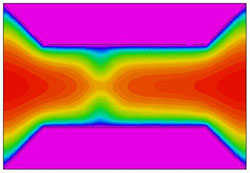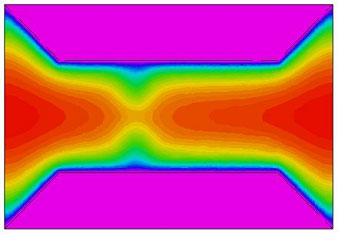Electrons Take Turns Like Pedestrians
When electrons are put onto liquid helium, they skate like air-hockey pucks above the surface. In the 14 January Physical Review Letters, experimentalists report that, when they force a sheet of such electrons through a narrow constriction, the particles’ mutual repulsion causes them to take turns passing through, like a crowd of commuters going through a turnstile. The results show how a two-dimensional layer of electrons acts when their quantum nature is not important.
Confining electrons to a two dimensional sheet in a semiconductor at low temperatures produces dramatic behavior, such as the quantum Hall effect, where electrons can form a collective state with quantized values for the conductance. When this sheet is also narrowed in the sideways direction at one location to form a constriction, another quantum effect appears–the current-voltage relationship is completely different from that of a macroscopic wire, thanks to the wave nature of the electrons and their interactions.
But electrons in two dimensions can also behave as classical particles that interact only through the mutual repulsion of their negative charges. This occurs when they are spread much farther apart and has been difficult to achieve in the lab, so researchers are still seeing new phenomena. David Rees of RIKEN, a Japanese research institute, in Wako, Japan, and his colleagues, studied this regime using electrons floating above a liquid helium surface. At low temperatures, the electrons glide rapidly far above the surface–about 11 nanometers–and barely interact with it. At temperatures somewhat below 1 Kelvin, the repulsion between electrons generates a two-dimensional solid state known as a Wigner crystal. At higher temperatures the electrons act like a liquid.
In the past decade or so, researchers have learned to precisely control electrons above a thin layer of liquid helium that adheres by surface tension to tiny grooves on a solid wafer. Extending these techniques to smaller dimensions, Rees and his colleagues forced the electrons through a micron-wide constriction, comparable in size to the spacing between the electrons. The electric field there generated a saddle-shaped hill that was too high for electrons to cross. Increasing the voltage on an electrode lowered the barrier enough for electrons to pass through in single file, and the current suddenly appeared. Rees was surprised to see that further increases in the voltage produced additional sharp jumps in the current. These jumps occurred, the team later realized, because lowering the entire ridge created a wider opening for the electrons, so they could pass through two-abreast, then three-abreast, and so on.
The team used the shape of the electrostatic hill to estimate the expected voltage spacing between current steps. “It’s a rough calculation, but it seems to agree quite well with what we see,” says Rees. More sophisticated calculations by collaborators, still underway, confirm this description, although calculating the response of a system of electrons, each repelling the others, is challenging.
For their first results, the team measured the electron current at a temperature of about 1.2 Kelvin. At this temperature, the electrons in a sheet keep away from their nearest neighbors but do not form a Wigner crystal. The researchers expect to extend the measurement to lower temperatures, where they would form a crystal and would need to be pulled out of the crystal to flow through the constriction.
The ordering of electrons caused by their repulsion has been used previously to explain experimental anomalies, says Mark Dykman of Michigan State University in East Lansing. But “I think this is the first direct experimental demonstration of the correlation of the electrons in the liquid phase.”
–Don Monroe
Don Monroe is a freelance science writer in Murray Hill, New Jersey.
More Information
Wigner Wire: Electrons Act Orderly–Focus story on crystalline ordering of electrons above liquid helium





